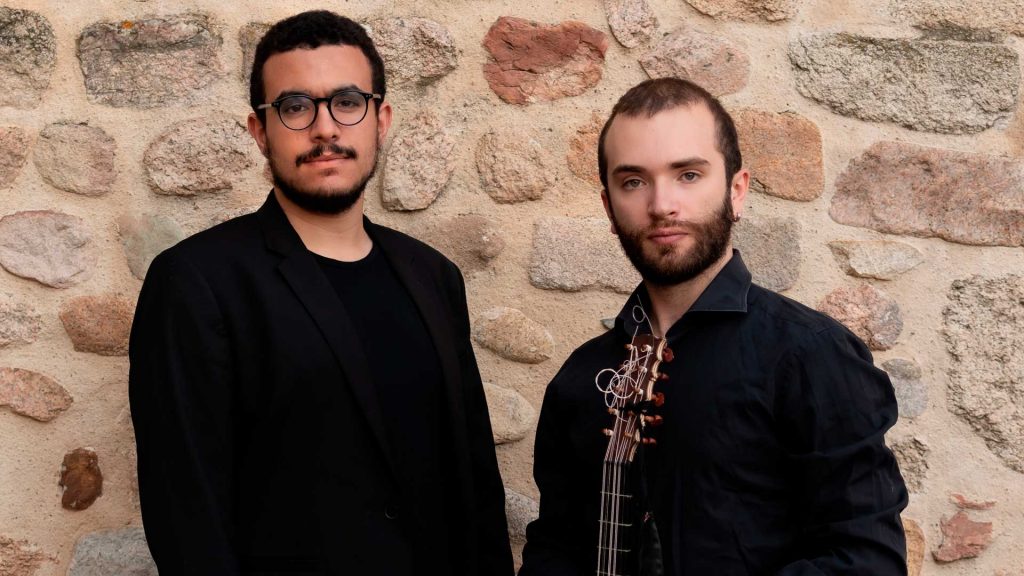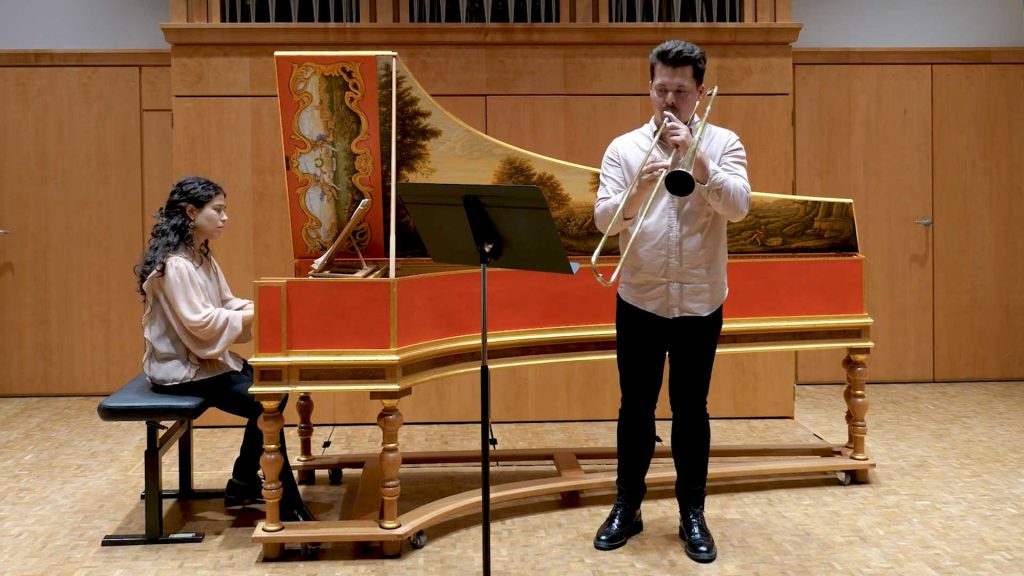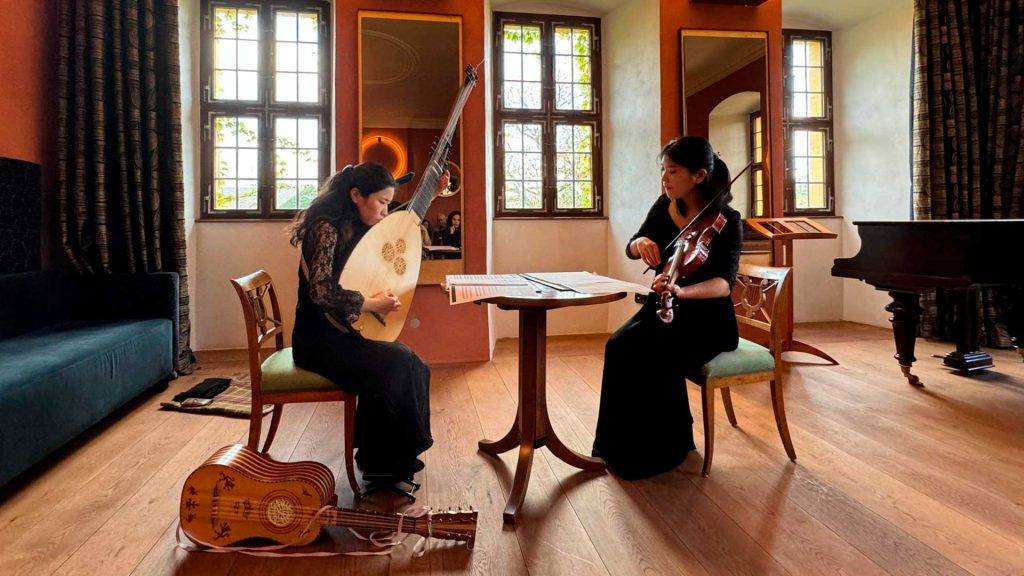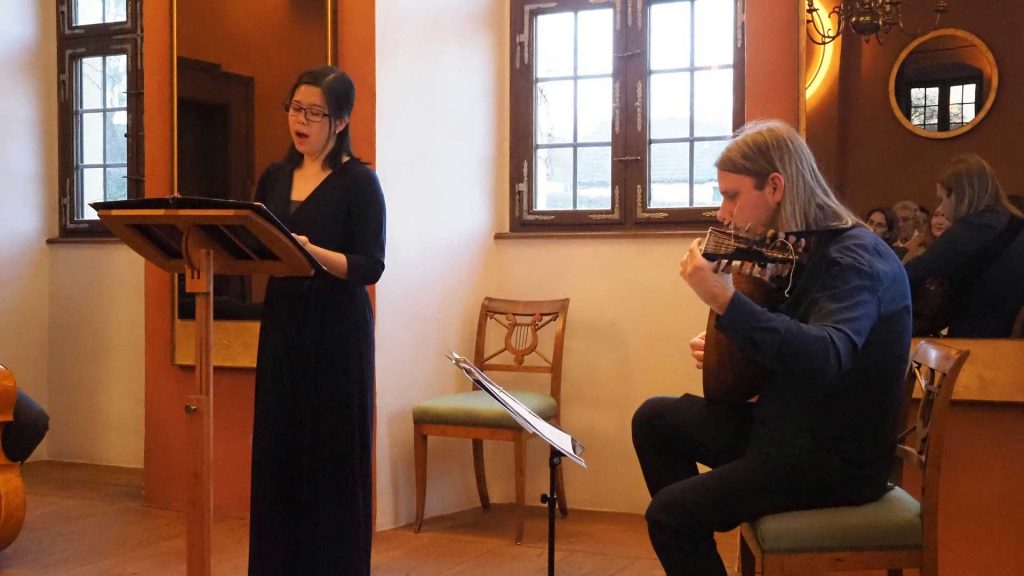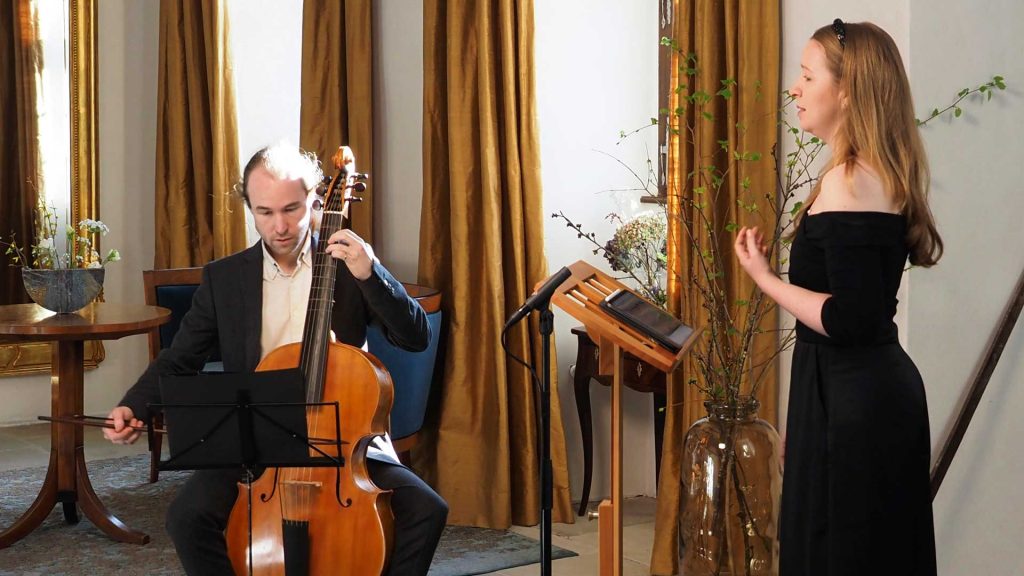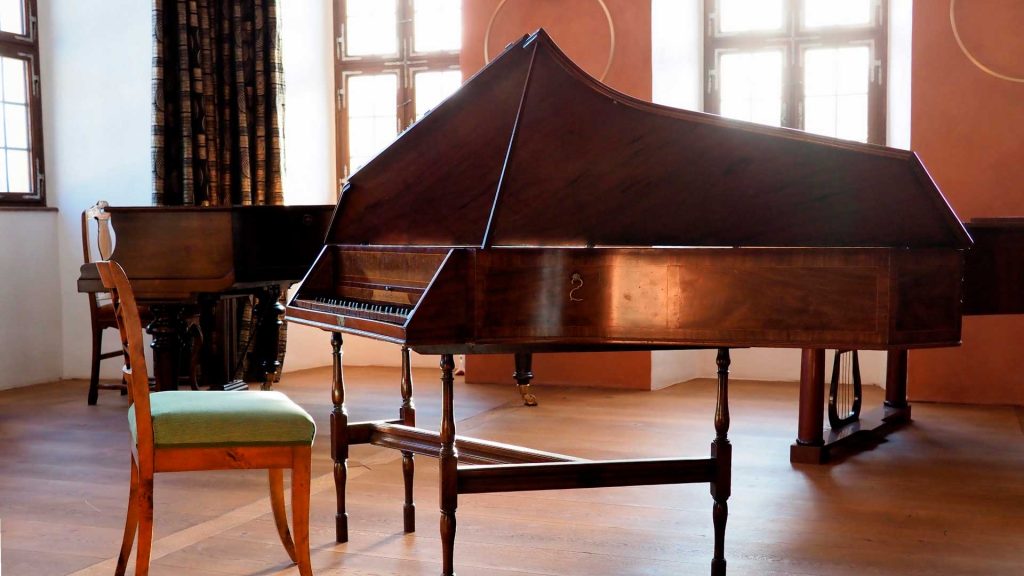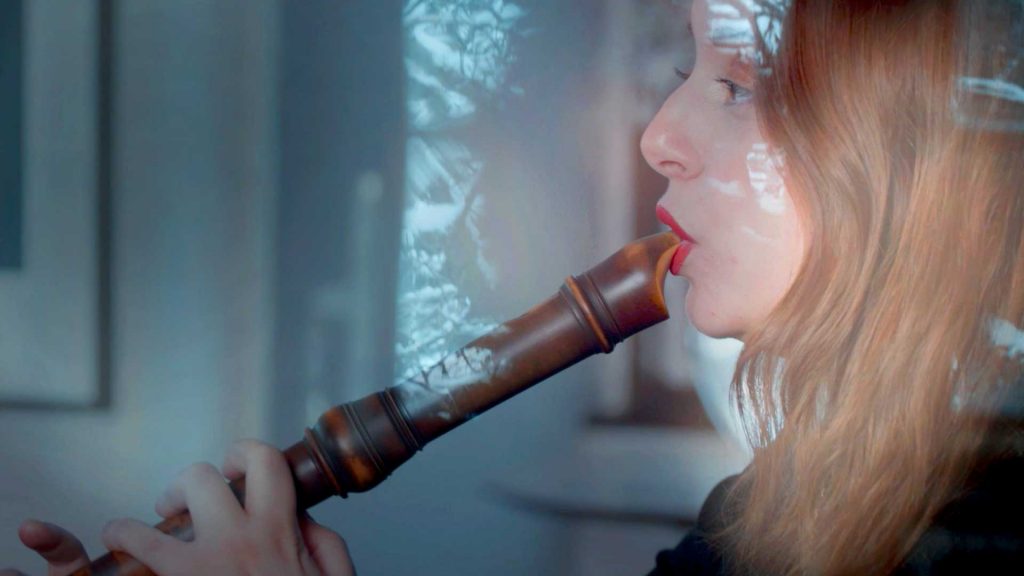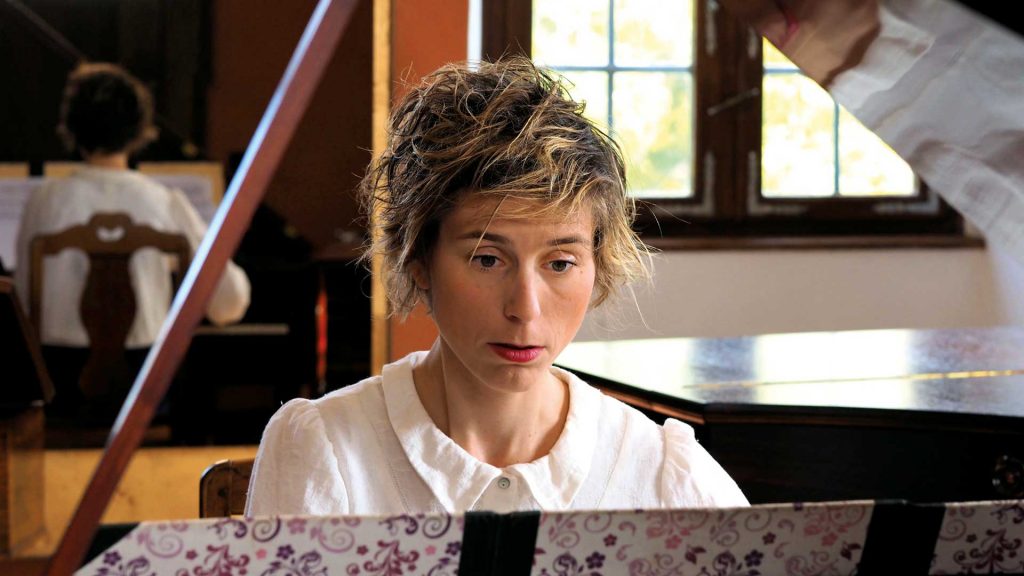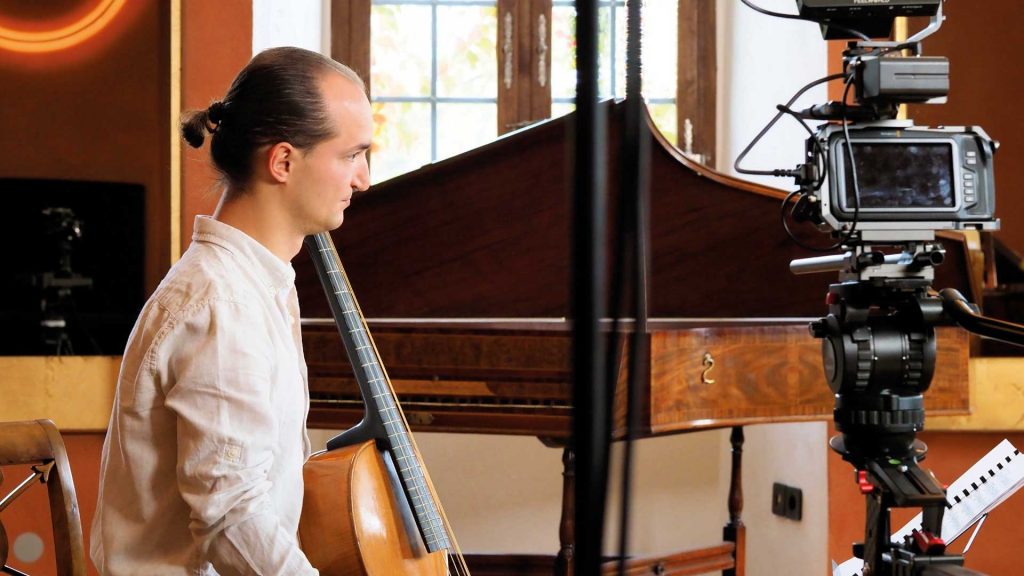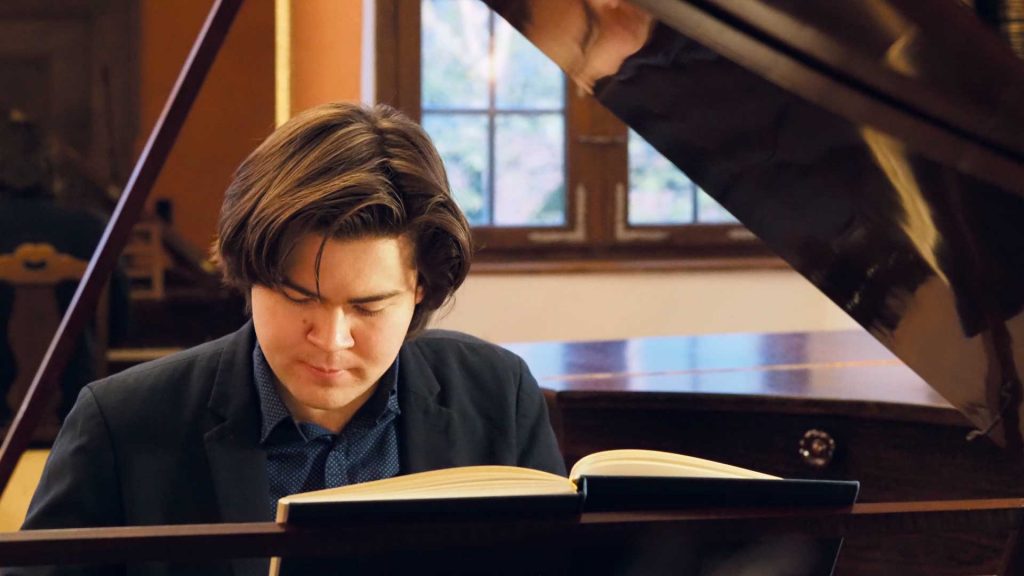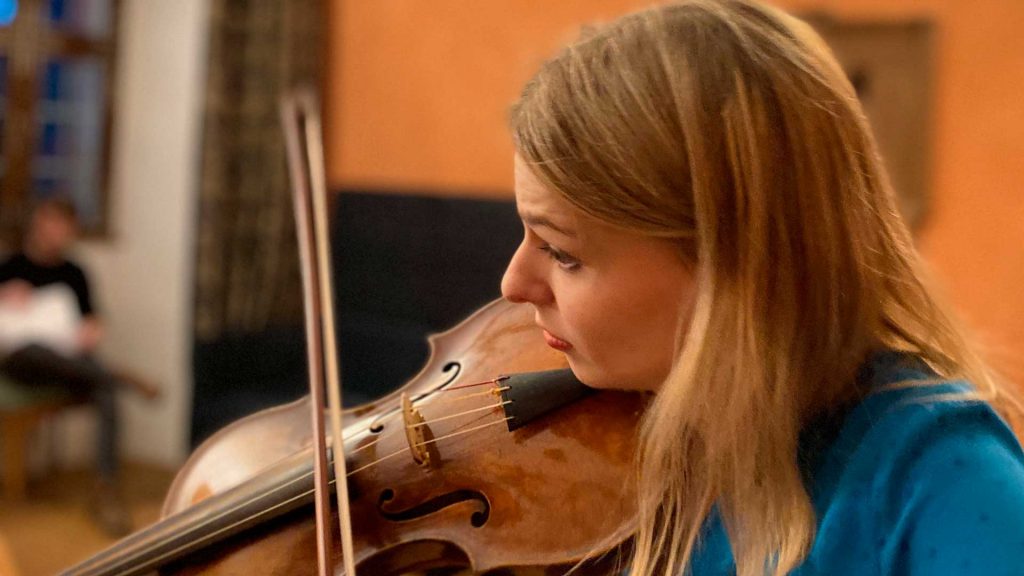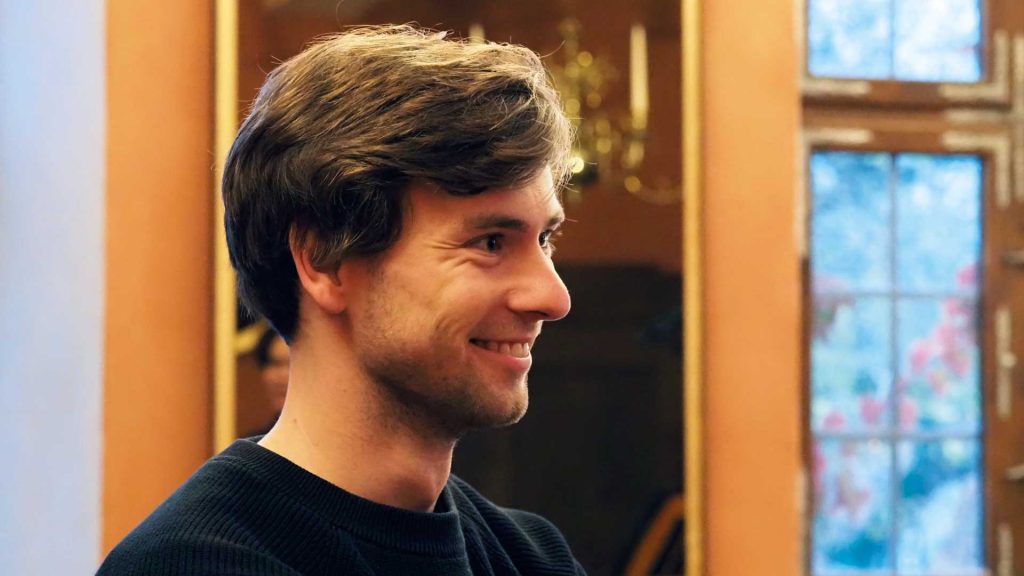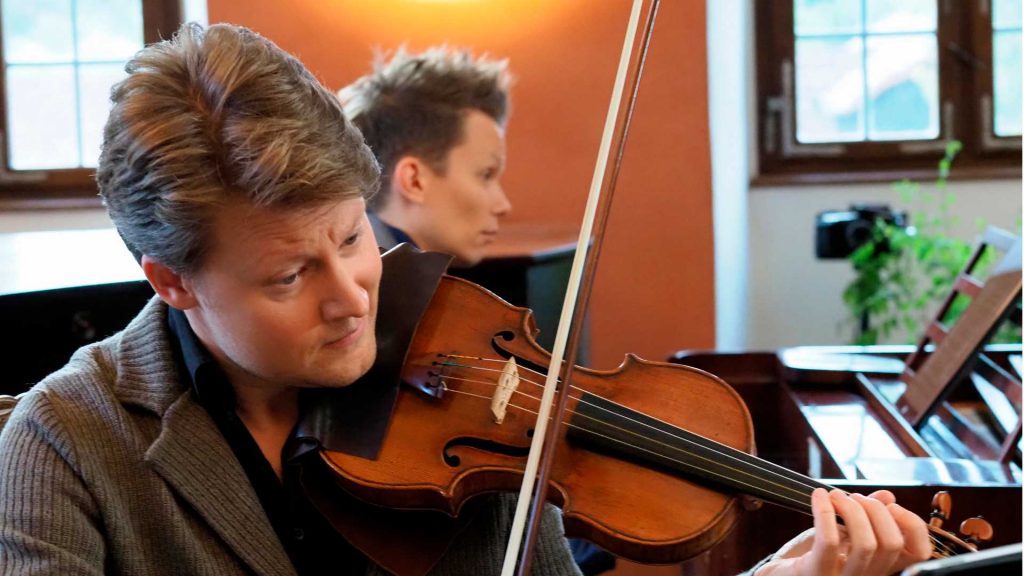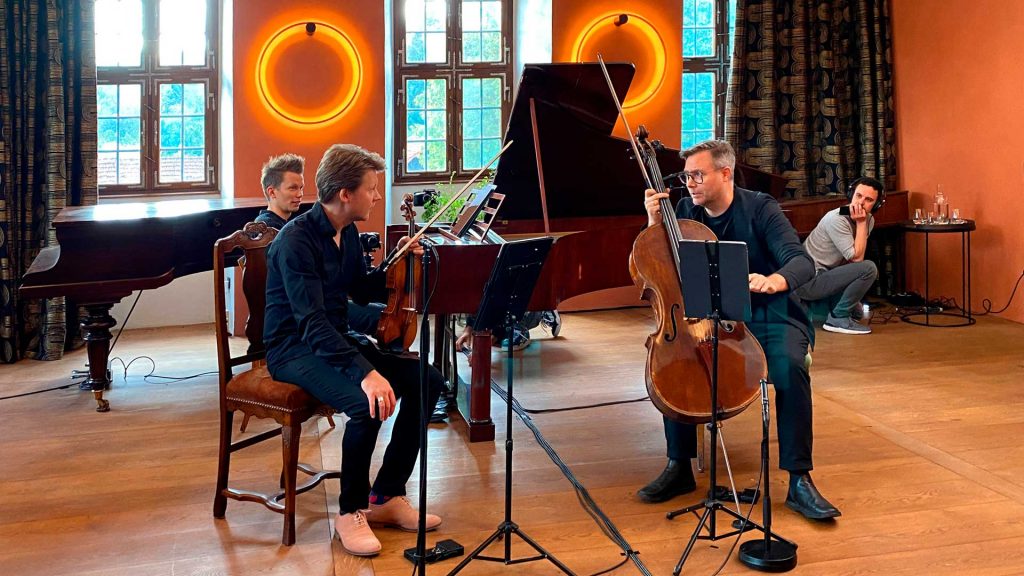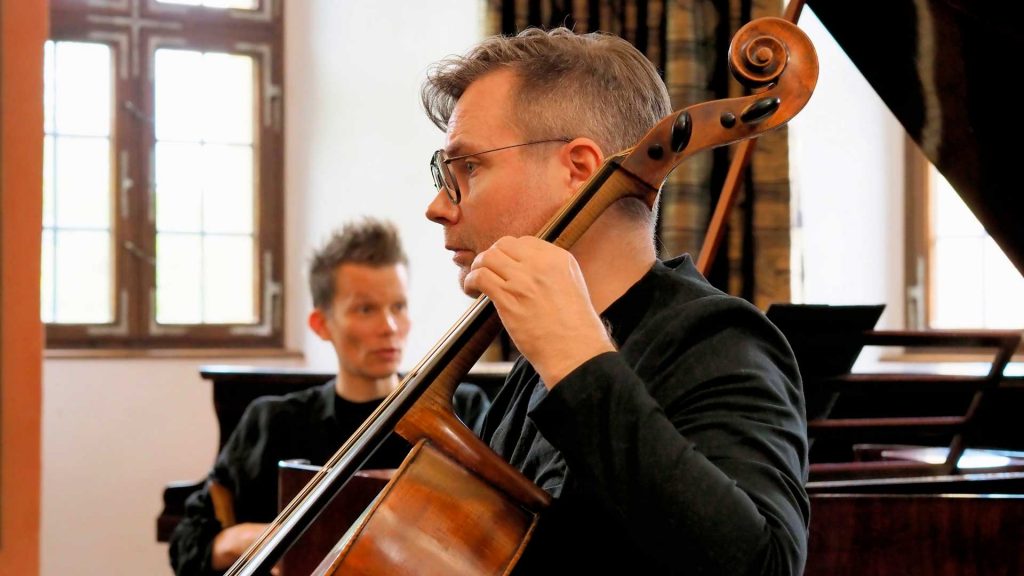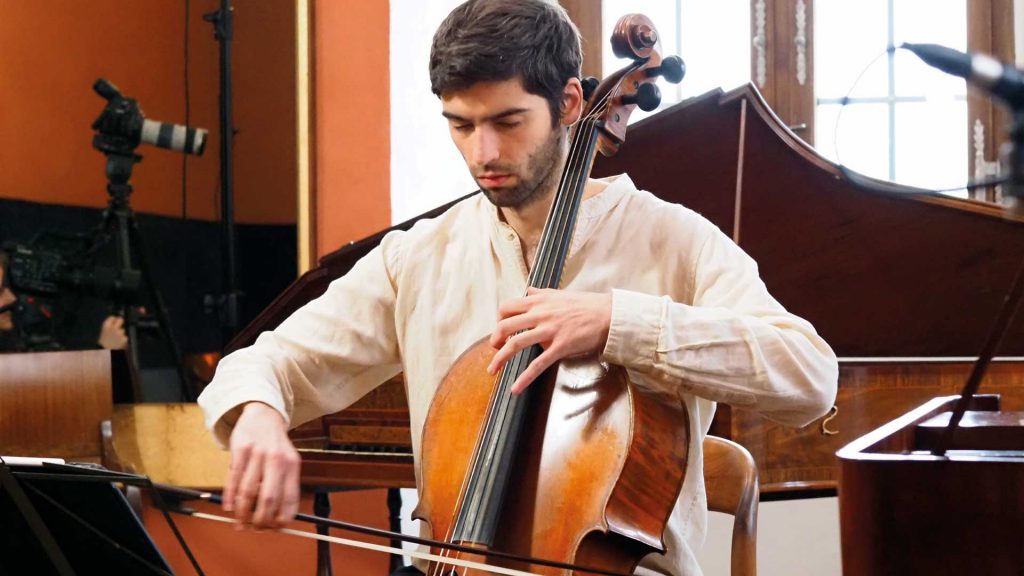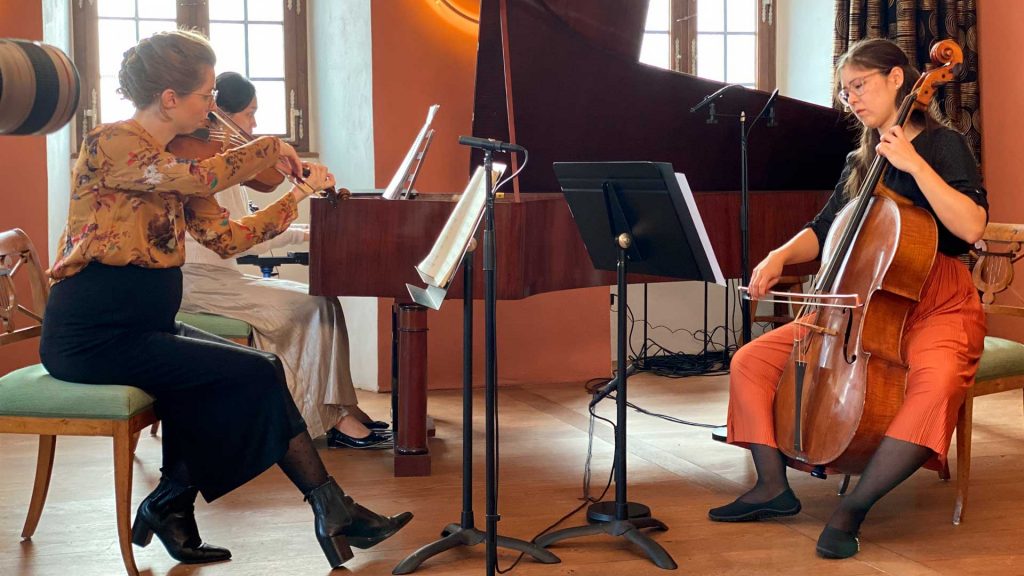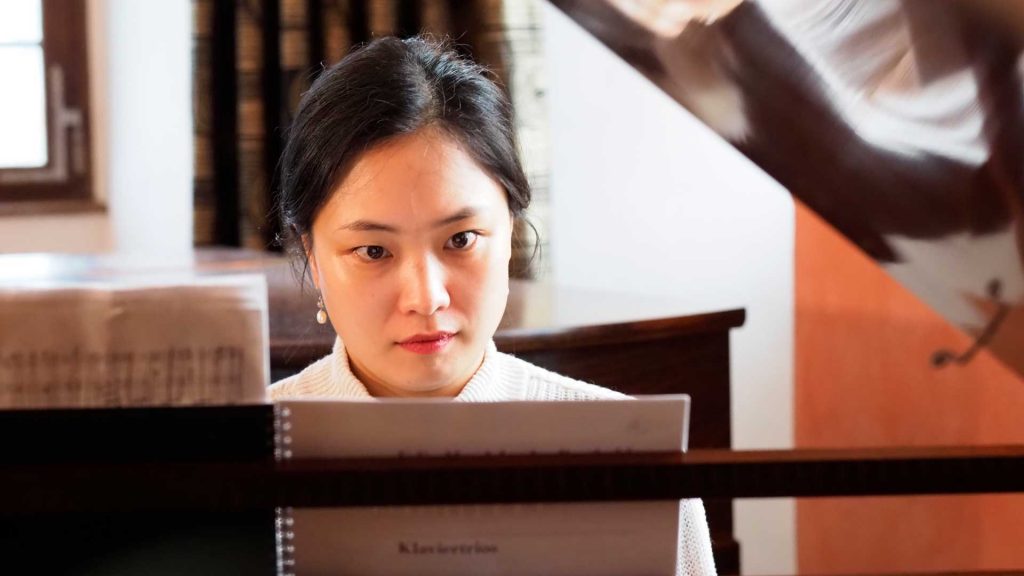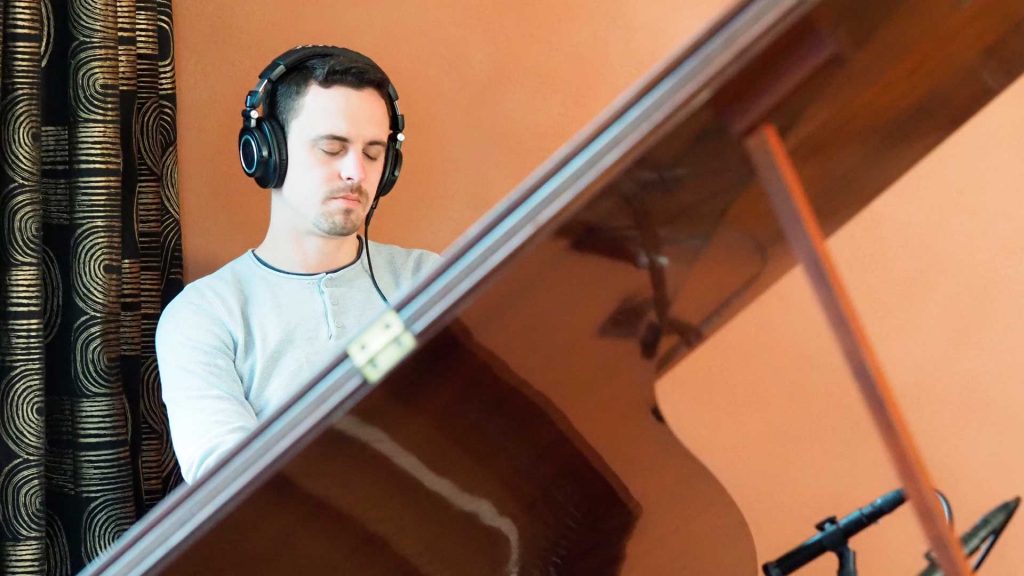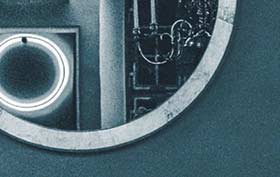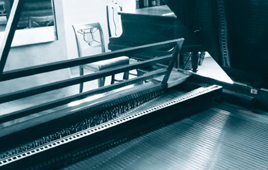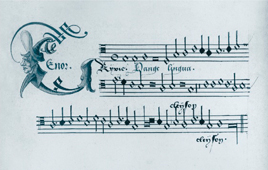This programme is advertised annually by the Schloss Weißenbrunn Foundation, for different groups of musicians every year. It is intended to promote ensembles who breathe life into historical performance practices with innovative programme design, high musicality and excellent playing technique.
The scholarship comprises the possibility to rehearse and perform, including film recordings, as well as accommodation in the castle’s guesthouse.
Ensembles may apply, and there is no age limit. Details and rules for the application are published with the respective call for applications.
Artist-in-Residence 2024
Projects on the Topic of Ornamentation in the Early and Late Baroque Eras
In 2024, the Artist-in-Residence Programme offered by the Schloss Weißenbrunn Foundation will be for ensembles comprising between 2 and 5 musicians who have dedicated themselves to the topic of diminution and ornamentation in the Baroque era.
Duo Nastasi & Belkheiri
Gabriel Belkheiri, tenor · Jérémy Nastasi, guitar and theorbo moreLes Harlequins
17th century ›air de cour‹ program
It was at the turn of the Renaissance and the Baroque that the polyphonic song which sublimated the poetry of Ronsard and DuBellay under the reign of the last Valois, gives way to the air de cour at the beginning of the 17th century. The intermingling of voices in polyphonic settings gradually evolves into a monody accompanied by a guitar or a lute – harmonic instruments brought back from Italy and Spain in the sandstone of warlike or matrimonial exchanges – and so in their simplest version, entertain the court with only two artists at all times, in all places.
Initiated under Henry IV, the Air de Cour sees its apogee with Louis XIII before disappearing under the Sun King or rather to transmute into airs for French cantatas or tragédies lyriques dear to Louis XIV.
Inspired by the famous entrée that Lully composed for his comédie-ballet Le Bourgeois Gentilhomme, L’Éntrée des harlequins, the duo presents a compendium of midd 17th century airs de cour representing each of them a pathetic character from comedia dell’arte, in a ›pathetic‹, or better said, ›vintage‹ style and aesthetic for Lully’s times.
We will find a table of different affects of amorous passions with a pronounced taste for naturalist allusions, as well as a refined musical field for florid vocal and instrumental ornamentation.
Concert Programme
Le melancolique
Constantijn Huygens (1596–1687), Grave tesmoins de mes delices
Le désireux
Michel Lambert (1610–1696), D’un feu secret je me sens consommer
Le rêveur
Robert de Visée (c. 1650/60–c. 1732 ), Suite en Ré Majeur (1686), Prélude · Allemande · Srabande · Chaconne des Arlequins
Joseph Chabanceau de la Barre (1633–1678), J’avois juré de n’aymer plus 1669
L’amourante
Air de cour de Michel Lambert 1660, doubles de Jacques-Martin Hotteterre 1721, L’amour le seul amour
Le plaintif
Robert de Visée (c. 1650/60–c. 1732), Suite en do m., Prélude · Allemande , ‘Tombeau pour mesdemoiselles de Visée’ · Sarabande
Michel Du Buisson (16?¿–1710), Plainte sur la mort de Monsieur Lambert 1696
Le fortuné
M.A. Charpentier (1643–1704), Sans frayeur dans ces bois
Santiago de Murcia (1673–1739), Diferencias sobre Marizapalos
Étienne Moulinié (1599–1676), Por la verde orilla del claro Tormes
Le charmant
Gaspar Sanz (1640–1710), Canarios 1674
Étienne Moulinié (1599–1676), Concert des differents oyseaux
Duo ›Con Dispositione e Gratia‹
Henry Van Engen, trombone · Rafaela Salgado, harpsichord and organ moreProject description
Con Dispositione e Gratia
Exploring Passaggi for Trombone and Keyboards
… se altri per aventura dicessero, che io havessi posto alcuni Passaggi, che paiono impossibili à farsi con viva voce, risponderò loro, che essendo essi dalla natura dottati di buona dispositione di voce ne faranno anco di più difficili assai …
… if others should happen to say that I have set some passaggi which seem impossible to perform, I would say to them that if they are blessed with good dispositione of the voice, they will manage even much harder ones … (translation: Gawain Glenton)
In the introduction to his monumental ornamentation treatise Regole, passaggi di musica of 1594, Giovanni Battista Bovicelli sets the scene for early baroque ornamentation, that if one has good dispositione or ›disposition‹, one will be able to perform complex and difficult passaggi or ›passages‹. This key word dispositione is echoed across many treatises from the late 16th and early 17th centuries, including Francesco Rognoni Taeggio’s Selva di varii passaggi libro primo of 1620. He expands upon the idea of ›disposition‹ in his listed advice to the reader and enriches the definition of making passages, requiring gratia or ›grace‹ as both a singer and instrumentalist:
1. Il portar della voce, vuol esser con gratia […].
3. Il Tremolo si fa sovente, mà però con gratia […].
5 Il principiar sotto alle note … non é altro, se non un dar gratia alla voce nel principiar delle note.
7. Volendo passar da una nota all’altra, fà bisogno portar bene la voce con gratia …
1. The portar della voce must be with grace […].
3. The tremolo one makes often, but with grace […].
5. The principiar sotto alla nota … is nothing other than a giving of grace to the voice in initiating the notes.
7. The necessity of passing from one note to the next makes it necessary to carry the voice well with grace …
(translation: Gawain Glenton)
That Rognoni Taeggio uses this key word in 4 of his 10 rules strengthens the need to have good ›grace‹ and ›disposition‹ for performing passaggi – this is exactly what we propose to do. With this residency proposal, we seek to have the place and time where we are able to invest in developing a program that consists not only of the ›passages‹ as published in historical sources, but to also add a layer of intricacy and depth by means of unequal rhythms, proto-affect, accenti, trilli, intonati and esclamazioni (i.e. grazie or ›graces‹). Moreover, we wish to cultivate our own system of passaggi, both improvised and written-out, and have the opportunity to develop a spontaneous rapport of ornamentation between the trombone, cembalo and organ, something that is often missing in today’s historical trombone practice.
To root our exploration of passaggi in primary sources, we have chosen to focus on the above – mentioned treatises by Bovicelli and Rognoni Taeggio for their usage of text and descriptions of basic ornaments, as well as Girolamo dalla Casa’s Il Vero modo di diminuir of 1584, Giovanni Bassano’s Motetti, madrigali et canzoni francese of 1591 and Bartolomé de Selma y Salaverde’s Canzoni, fantasie et correnti libro primo of 1638 to show the evolution from the heyday of the 1580’s and 90’s to the final surviving treatise that contains new material.
Within the collection at Schloss Weißenbrunn, the 16th century virginal with short octave, the 12’ Italian harpsichord of 1699 and the Neapolitan organ from 1724 with short octave are of particular interest to us. Especially the possibility of testing various intabulation solutions after Diruta and Vicentino between 8’ and 12’ instruments makes these instruments especially well suited to our duo. In addition, the historical trombone is perhaps the most flexible instrument in terms of pitch and temperament and therefore ideally suited to working with multiple keyboard instruments over the course of a single concert.
Duo Minoriten
Minori Deguchi, violine · Asako Ueda, theorbo and guitar moreProject description
Ornamentation found in the works of Nicola Matteis
We are already excited to share our proposal, which will focus on the exquisite ornamentation found in the works of Nicola Matteis. As a violin and theorbo/guitar duo, we hold Matteis in high regard due to his dual mastery as both a renowned violinist and a magnificent guitarist.
Our exploration of Matteis’s artistry will be twofold. Firstly, we’ll delve into his unique fusion of styles, reflecting his Italian roots and the influence of the English Divisional tradition during his time in England. Specifically, we will closely examine his compositions, with a special emphasis on his four collections of ›Ayres for the Violin‹, a perfect fit for our ensemble.
Secondly, we will explore Matteis’s use of ›grace‹. Drawing from a wealth of historical treatises such as John Playford’s »A Breefe Introduction« (1654), Christopher Simpson’s »Division-Violist« (1659), The Burwell Lute Tutor (c 1660–72), Matthew Locke’s »Melothesia, or Certain General Rules for Playing upon a Continued-Bass« (1673), Thomas Mace’s »Musick’s Monument« (1671–76), Pietro Reggio’s »The Art of Singing« (1677), Nicola Matteis’s »Le false consonanse della musica« (c 1680; Eng. trans., 1682) and Henry Purcell’s »The Choice Collection of Lessons« (1696), we’ll gain valuable insights into Matteis’s ornamentation techniques. Our journey begins with an in-depth study of these treatises, followed by the practical application to Matteis’s music.
After this thorough investigation into his compositions, we aspire to craft a concert experience that encapsulates the fruits of our labor. Our performance will encompass a delightful selection of Italian and English music, serving as an introduction to these two distinct styles. The second half of the program will feature Matteis’s masterpieces, wherein we will try to add/improvise ornaments/graces in the style of the composer.
Ensemble Musica getutscht
Erika Tandiono, soprano · Julius Lorscheider, harpsicord · Bernhard Reichel, lute and theorbo moreFrom the project description:
Recitar / Catando
The Secret Art
In Baroque music, ornamentation begins with the performance, through the introduction of character by adding character, gestures, tone colour, dynamics or added notes. In his classical work »Musik als Klangrede«, Nikolaus Harnoncourt states that in music before 1800, the work. i.e. the composition, was written down, and that the performance with all its interpretative parameters could not be read from this notation (with a few exceptions we will come to later). In his words, it is only from around 1800 that notation can be read as a performance instruction.
However, it is difficult to find a history of performance (and thus also ornamentation), if you consider that the great musicians of the Italian modern era were also actively creating music. Women were generally excluded from creative activities, though, since they were neither considered to have the intellectual skills nor were they trained accordingly. Their art has only been passed down in a vague form and only found its way into the great canon in an indirect manner. But in the musical history of women, it is possible to find what more or less corresponds to the contemporary concept of the interpreter: the performance of someone else’s work. Thus a history of musical ornamentation can also be read as a socio-political history of women.
When searching for the art of musical ornamentation, the ensemble »Musica getutscht« came across a number of oral traditions and secret arts of the women of the Italian Renaissance and early Baroque periods. We would like to follow this thread over more than a century:
Starting with reconstructions of sonnet recitations (ornamentation of texts through music) at the court of the patroness Isabella d’Este, we will then continue our journey with the art of ornamented singing of the »Concerto delle Donne« in Ferrara und will finally arrive at the incredibly virtuoso singer Vittoria Archilei only whose ornamentation gave meaning to compositions, as Jacobo Peri claimed. The circle will then close with Francesca Caccini’s art of recitation and singing, as well as the male adoption of this art of ornamentation in the early Baroque period.
On this journey of discovery we will encounter female poets and composers who freed themselves from the corset of being only the »muse« and became active creators against all resistance, blurring the boundaries between ornament and composition, between composer and interpreter, and we will realise that the significant artistic skills of women in the Italian early Baroque period have had a lasting impact on music history.
Concert Programme
… »cantar sonetti« at the court of Isabella d’Este 1500–1550
Francesco Da Milano, Ricercar
Bartolomeo Tromboncino, Come haro dunque ardire (Michelangelo Buonarroti)
Bartolomeo Tromboncino, Hor che’l ciel e la terra (Francesco Petrarca)
Modo di cantar sonetti 1505, Sonnet by Tulla d’Aragona
Modo di cantar sonetti 1505, Sonnet by Gaspara Stampa
The secret art of women 1550–1600
Maddalena Casulana, O notte, o cielo, o mar (1570)
Isabella de Medici, Lieta vivo et contenta
Luzzasco Luzzaschi, Ricercar
Luzzasco Luzzaschi, Aura suave (c. 1580)
Cristofano Malvezzi / Vittoria Archilei, Dalle più alte sfere (1589)
recitar cantando 1600–1620
Giulio Caccini, Tutto’l dí piango (Francesco Petrarca) (1601)
Jacobo Peri, Al fonte, al prato (1609)
Giovanni Kapsperger, Aria di Firenze
Francesca Caccini, La Pastorella (1618)
Singing Torquato Tasso
Sigismondo d’India, Sovente, allor che su gli estivi ardori (1609)
Sigismondo d’India, Indi dicea piancendo (1609)
Sigismondo d’India, Forse avverrà se’l ciel benigno ascolta (1609)
Accenti
Hannah Ely, voice · Harry Buckoke, viol Concert Film »The Artful Musician«Artist-in-Residence 2023
Programme for Baroque Ensembles with Spinet
The focus of the 2023 Artist-in-Residence programme is the 1768 original spinet by Neil Stewart. The jury (Flóra Fábri, Thomas Leininger and Pia Praetorius) chose three ensembles who managed to convince them with their application tailored to this instrument, with exciting programmes as well as their high musical, stylistic and technical proficiency. For the first time, an additional scholarship, for Young Artists-in-Residence, was awarded giving an ensemble at the beginning of its career the opportunity to present itself in a concert and film recording, and to develop in the encounter with historical instruments and their special sound.
La Tabatière, one of the four ensembles chosen as artists-in-residence, no longer exists in the formation of their application and will therefore not take up their residence week.
Our 2023 Artists-in-Residence
Cicerone Ensemble
Thomas Wormitt, traverso · Andreas Gilger, spinet Concert Film »Concert film "On Her Majesty's Musical Service"«On Her Majesty’s Service
The kings and queens of the 18th century – one might think – did not lack for anything. But if you were a woman promised to a foreign ruler in marriage, you had to be prepared for possibly a lot of sadness and most of all loneliness. This is what Queen Charlotte may have experienced when she moved to England as the German wife of King George III – without speaking a single word of English. But as Queen she soon found ways and means to deal with her homesickness and founded the Queen’s Chamber Band, a chamber music ensemble at the English court whose members had one thing in common above all: they were German.
For our Artist-in-Residence project we put together a duo programme with works from the sphere of Queen Charlotte. The spinet switches roles, from basso continuo to obligato accompaniment or solo playing with accompanying flute. In a virtuoso competition, works by the Queen’s most important musical acquaintances will be heard. This music not only helped Charlotte to alleviate her homesickness, but also to get closer to her husband. For it was mainly their love of music and playing music together that was the bond between them. This happiness was not to be long-lived, though: after a few years of marriage – without Charlotte initially getting to know about it – there first signs of the King’s mental illness began to appear, an illness which was to weigh deeply on her in the years to come.
The works in our programme – written in happier days when Charlotte and George pursued their joint passion for music together – tell of a vibrant music scene, of historic encounters, of successful concert series, and of a Queen and her destiny.
Concert Programme
Works by Johann Christian Bach (1735-1782), John Stanley (1712-1786), Carl Friedrich Abel (1723-1787) and Johann Christian Fischer (1733-1800).
Duo Alter Ego
Eleonora Bišćević, traverso · Arianna Radaelli, spinet Concert Film »An Italian Gallery«From Duo Alter Ego’s project description:
An Italian Gallery
In the mid-18th century, Great Britain was one of the world’s most important cultural centres: major cities attracted numerous foreign musicians who often settled and worked there. Just think of Handel, Hasse or Porpora, for example, who could assert themselves as first-rate opera composers in London, thanks to support by the Opera of the Nobility or the Royal Academy of Music.
Among those international artists, Italians were a very well-represented national group: many Italian virtuosos found enthusiastic audiences in Britain with their brilliant playing, and accordingly numerous collections of chamber music were created in the British Isles.
Our project therefore looks at music for traverso and keyboard instrument (be it as continuo or obligato instrument) by Italian composers who were active in Great Britain in the so-called late Baroque period. This is repertoire you could even imagine to have ideally been performed by our line-up in the times of Neil Stewart’s original spinet. It is mainly galant music: repertoire rich in contrast and colours in which a spinet and a traverso feel very much at home.
The influence of the violin and its music is clearly visible in this music, of course, and it had been Italy where an extremely important tradition had begun with Corelli and his pupils.
The rarely performed flute repertoire from that time often came from violinists or consisted partly of adaptations and arrangements of violin music. We have been intensively involved with this approach to the violin: we regularly play music scored for the violin, not only in historical arrangements (we recently recorded Corelli’s sonatas in their historical arrangement), but also in our own arrangements inspired by historical sources, and we explore the relationship between these two instruments.
This relationship is also noticeable in our programme suggestion for this new project. The instrument we would be playing is particularly exciting for us: the sound of a spinet can get even closer to that of the flute than a harpsichord can, and so creates a more intimate atmosphere.
We intended to design our programme to be similar to a gallery of paintings: as a contrasting yet consistent sequence of portraits by different authors.
Concert Programme
Works by Francesco Maria Veracini (1690 – 1768), Giacobbe Basevi “Cervetto” (1680 – 1783), Johann Christian Bach (1735 – 1782), Pietro Castrucci (1679 – 1752) and Francesco Xaverio Geminiani (1687 – 1762).
Ibera Auri
Laia Blasco López, soprano · Gabriel Belkheiri García del Pozo, tenor and recorder · Lidia Rodrigo Royo, spinet · Jérémy Nastasi, Baroque guitar Concert Film »El balcón de Marizápalos«Ibera Auri is awarded an additional fourth scholarship as “Young Artist-in-Residence 2023”
From Ibera Auri’s project description:
The balcony of Marizápalos
Iberian Music of the 17th century and its influence on Europe
In the 17th century, María Calderón, aka Marizápalos, was the mistress of Spanish King Philip IV. At the Queen’s request she had to watch events on Madrid’s Plaza Mayor from a balcony located at some distance from the royal balcony, and this famous balcony is named after her.
Ibera Auri would like to look across the borders from the ensemble’s “Iberian balcony”, while immersing themselves in the Iberian musical tradition of the 17th and 18th centuries. At the Spanish court of King Philip IV and Queen Isabel (a sister of French King Louis XIII) and thus also in the sphere of Marizápalos, various musical traditions influenced each other, in particular the French and Spanish traditions. While the King probably preferred Spanish cantatas, folk songs and zarzuelas, the Queen might have enjoyed the Airs de Cours from her French home country.
In its programme, Ibera Auri would like to show how the Iberian musical tradition was present in the rest of Europe during the Baroque period, right through to the 18th century, and how it was also closely interwoven with other European traditions. For our programme, we explored repertoire from various sources recorded and published in Spain, Portugal, Italy, France and England.
Concert Programme
Works by Antoine Boësset (1587-1643), Etienne Moulinié (1585-1665), Michel Lambert (1610-1696), Antonio Martin y Coll (1660-1734) and Sebastián Durón (1660-1716), as well as works by anonymous composers.
.
Artist-in-Residence 2022
Programme for ensembles with strings and fortepiano
The 2022 Artist-in-Residence Programme was offered for ensembles with strings and fortepiano, focussing on the original fortepiano made by Josef Brodmann in 1827.
The programme has the goal of promoting artists who breathe life into historical performance practices with their innovative programme design as well as excellent musicality and playing technique.
It supported four ensembles with rehearsal spaces, as well as a film recording and live concerts.
In addition to the scholarships comprising film and concert performance, the duo Anders Muskens and Aleksandra Kwiatowska were awarded a scholarship for a CD recording.
Duo Belogurov & García García
Artem Belogurov, fortepiano · Víctor García García, violoncello Concert Film »Bernhard Romberg und Ferdinand Ries ›On Tour‹«The focus of this programme presented by these two young, highly talented musicians will be on music by Ferdinand Ries and Bernhard Romberg. Romberg, presumably the most prominent central European cellist of his times, had a close working and personal friendship with Beethoven pupil and composer, Ferdinand Ries. These two composers made a tour through Russia, Moldavia, Ukraine, Romania and Estonia. In addition to works written especially for this endeavour, the focus of the programme is also on improvisation – an art practiced both by the composers and today’s artists – live in the castle’s Music Salon and in a concert film.
Duo Fábri & Jantzen
Flóra Fábri, fortepiano · Martin Jantzen, arpeggione Concert Film »Schumanniade«Flóra Fábri and Martin Jantzen applied for the scholarship with the unusual combination of fortepiano und arpeggione. With their programme, they would like to explore which music is most closely related to the character of the arpeggione, and they want to highlight new facets through the transformation of arrangements. They will combine the music of Clara and Robert Schumann, marked by Romantic depth, with that of Johann Sebastian Bach.
The arpeggione is particularly suited to emotional and rather fragile works – not without reason, contemporaries called it the “sentimental guitar” or “violoncelle d’amour”. Interestingly enough, the instrument’s similarity to the viola da gamba was also remembered. This was already was remarked upon in the first newspaper articles reporting about the instrument after its “birth”.
The two musicians want to build a bridge between these two fairly distant eras. They intend to build on this experiment and create further programmes of this kind.
Rödberg Trio
Joonas Ahonen, fortepiano · Antti Tikkanen, violine · Markus Hohti, violoncello moreIn their Artist-in-Residence Programme, the Rödberg Trio want to dedicate themselves to piano trios by Clara and Robert Schumann and by Niels Wilhelm Gade.
Trio Radiant
Judith von der Goltz, violine · Sylvia Demgenski, violoncello · Juin Lee, fortepiano Concert Film »The Candid Gaze – A Concert Sonata«Trio Radiant will play works by Fanny and Felix Mendelssohn, by Clara and Robert Schumann and Louise Farrenc.
They juxtapose – on an equal footing – works of the famous male composers and the rather forgotten works by the female composers who were related to these men.
The central focus is a merged version of two piano trios by Felix Mendelssohn and Fanny Hensel. They are intended to grow into one, forming a symbiosis, just as Fanny and Felix maintained a symbiotic relationship throughout their lives. Creating a kind of F-A-E sonata by these two siblings.
Around this there is a group comprising the loving Schumann couple (with a Trio and a Fantasy) and Louise Farrenc (with Trio Op. 11).
Artist-in-Residence 2021
Programme for ensemble with Baroque harp
In 2021, the Schloss Weißenbrunn Foundation Artist-in-Residence Programme was offered for ensembles with Barque harp with between 2 and 5 musicians.
Duo L’Oro
Friederike Merkel, recorder · Babett Niclas, Baroque harp Concert Film »Soñar-Soñar«A wide variety of sounds, styles and instruments can be experienced in the film Soñar-Soñar. Traditional Sephardic and Irish music, works by Arvo Pärt and Hildegard von Bingen are side by side with Renaissance and Baroque compositions, played on recorders of different sizes and design, accompanied by harp, percussion and live electronic music. How exciting to see and hear what two highly talented musicians and an equally talented filmmaker have created in the impressive atmosphere of the castle’s barn at Schloss Weißenbrunn. Not to be missed!
Duo L’Oro
Friederike Merkel and Babett Niclas who also regularly play together in other ensembles, in Duo l’Oro indulge their virtuoso joy of playing music and their love for intricately detailed arrangements. This resulted in concerts at the Innsbrucker Festwochen, zamus: Köln, Schleswig-Holstein Musiksommer, Heinrich Schütz Musikfest, Felix URBAN, in the Museum of Fine Art in Leipzig and in the Pergamon Museum in Berlin. With the experimental ensemble Soundtravelers, Babett Niclas was honoured with the “D-bü” award of the German Music Academie in 2017.
Cordis Consort
Carlotta Pupulin, Spanish Baroque harp & Juan José Francione, Baroque guitar Concert Film »Zifras Armónicas«The exciting combination of harp and guitar, played by two exceptional young artists, this promises to be an unusual film experience.
A Journey from Toledo to Madrid, that is the title they gave to their concert film. The programme’s focus is on two Baroque composers: one of them – Santiago de Murcia – was a guitarist and lived in Madrid, the other – Diego Fernandez de Huete – was harpist at Toledo Cathedral. His main work, “Compendio numeroso de zifras armónicas” provided the title for this concert.
Cordis Consort
The Cordis Consort ensemble was born from the idea of Juan Josè Francione and Carlotta Pupulin to revolve around plucked instruments, concentrating the work of studying the repertoire on original material for harps, guitars and lutes. The use of original material written for solo instruments has led to intensive arrangement work, so that what was originally written for one instrument could be played on two or more instruments. The arrangements are influenced not only by the knowledge of early music and basso continuo but also by the Latin American folk repertoire, which in turn is strongly influenced by Spanish culture and sounds.
Carlotta Pupulin on Facebook Juan José Francione on Instagram
Duo Torrez & Ehrhardt
Angelica Monje Torrez, contralto · Maximilian Ehrhardt, Baroque harp Concert Film »Il mio bel traditore«Artist-in-Residence 2020
Programme for Lied Duo
The 2020 Artist-in-Residence Programme was offered for Lied Duos performing music from around 1800, centred on the original fortepiano by Melchior Guante (around 1790).
Lied Duo HiP Wien
Johanna Rosa Falkinger, soprano · Aleksandra Kamenskaja, fortepiano Concert Film »Zwischen Salon und Spelunke«Music from Vienna from around 1800 is showcased in this unusual concert which moves between two worlds: parlour and pub. There is the old woman grumbling that everything used to be better in the olden days (in an amusing and mischievous setting by Mozart), there is Beethoven’s idiosyncratic version of the folk song »Alle Vögel sind schon da« (All the Birds Are Already Here), and there are gentle, melancholy sounds in Haydn’s »Das Leben ist ein Traum« (Life is but a dream). Just like life itself, with is many facets, and continually surprising. Presented in a lively performance by two young musicians from Vienna, with poetic images from the castle and the park. Enjoy!
Lied Duo Mauch & Leininger
Monika Mauch, soprano · Thomas Leininger, fortepiano Concert Film »Arianna a Naxos«One of the most popular topics from Greek mythology is the focus for the concert film featuring two well-known musicians, Monika Mauch and Thomas Leininger: »Arianna a Naxos«, set to music by Joseph Haydn. After their joint victory over the Minotaur, Ariadne, for love of Theseus, follows him to the island of Naxos. In the beginning, Haydn describes her waking up and longing for Theseus whom she supposes to be out hunting. However, when she climbs a high rock on the island, she sees that Theseus is leaving her aboard a ship. Haydn impressively sets to music Ariadne’s lamentation and anger about the unfaithfulness of this man. Musical drama extraordinaire.
Lied Duo Antonelou & Gandilyan
Fanie Antonelou, soprano · Sofya Gandilyan, fortepiano Concert Film »Der Erlkönig«Fanie Antonelou & Sofya Gandilyan did intensive work on their programme of poems by Johann Wolfgang von Goethe which were set to music in the time when the fortepiano by Melchior Guante was built. Works include compositions by Mozart and Beethoven as well as some by less well-known composers such as Zelter, Reichardt and Duchess Anna Amalia of Brunswick Wolfenbüttel. They concluded their residence in Weißenbrunn with another wonderful concert film.
Lied Duo Johannsen & Krampe
Daniel Johannsen, tenor · Matthias Krampe, fortepiano Concert Film »Wiener Melange«Daniel Johannsen, equally praised as subtle Lied singer and outstanding evangelist, and Matthias Krampe, Viennese conductor, organist and Lied accompanist serve up a “Vienna Mélange”, humorous and deep, containing both well-known and rarely heard music. A perfect blend of black humour and exuberant musicality. Enjoy!
